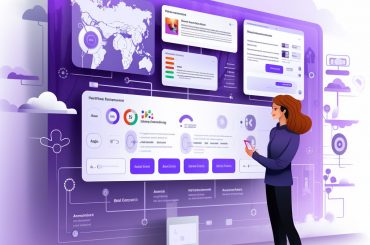Table of Contents
Being a business owner, you collect information about how your business is operating daily. You observe your staff, check bank account balances, and interact with your customers.
In addition, you also have to review financial reports like balance sheets and income statements. Along with these standard reports, you may also be tracking data on employee performance, sales, and operations.
It can be overwhelming to make sense of all that data. So, to streamline your data collection from diverse sources, a management reporting system is a great help.
The purpose of creating management reports is to provide the c-suite, decision-makers, and management with all the required data, essential for making strategic business decisions.
This way, you and other members of your management will have access to comprehensive reports of your overall management efforts.
To find out more details about management reporting, continue reading:
What is Management Reporting?
The term management reporting refers to a type of business intelligence that includes reports that are useful for business leaders to supervise the operations and performance of the company.
Management reports provide information about different aspects of the business to help you make better, informed decisions.
Being a core part of many advanced enterprise technologies, these reports help automate and improve the process of managing reports.
Besides reports, the process of developing reports is equally significant as it is essential to note how reports collect data from various departments of a corporation tracking their key performance indicators and presenting them.
Generally, these reports show the worth of a business over a specific period of time by disclosing its operational and financial information.
From management reporting, decision-makers get insights on how the business is performing, fostering them to find the right way to increase operational efficiency and make related decisions to stay competitive.
To accomplish this, many corporations utilize professional management reporting software.
What is Management Reporting System?
A management reporting system provides information- in the shape of reports or statements. This system helps management by providing them with real-time and relevant information.
Moreover, management reporting systems assist in capturing data required by managers to run a successful business. This data ranges from employee headcount, financial data, accounts, clients to products, investment performance, client assets held in custody, etc.
The usefulness of a management reporting system is multifold. However, listed below are six reasons why a business needs a powerful management reporting system:
- The reports are often unavailable to the right stakeholders at the appropriate time.
- There’s a constant need for reports for analysis of trends and decision-making.
- High-value resources are required.
- There’s a need for visibility and a single comprehensive view of the business performance.
- Duplicate data results in poor data management, and quality issues result in error-prone reports. Thus, there is a need to develop proper reports.
- To tweak a global report to fit local needs, a reporting system is essential.
What is Management Reporting Software?
Management reporting software provides managers with the readily available and digestible data that they need to make meaningful and long-term decisions.
This software has powerful visualizations with dashboards so that no information remains hidden.
By performing all the functions that help develop reports, the software eliminates the probability of human errors that can cause adverse business impacts.
Listed below are two examples of management reporting software:
ClearPoint Strategy Reporting Software
This reporting software streamlines and automates 70% of your reporting work so that you have enough time to carry out your plan. It gives you the tools to design the reports for any target audience quickly.
With its drag-and-drop interface, you can create dynamic reports, dashboards, and scoreboards quickly. It has compelling charts and visualizations that help you engage the audience.
You can develop data-driven reports automatically using the data from various sources and departments.
Moreover, you can also develop different reports for different audiences such as senior executives, board members, management teams, etc.
Workiva Management Reporting
Workiva management reporting software allows you to create internal reports without any associated risks. It helps you save time, connects diverse data sources- including different departments of your company- in a single environment.
Workiva automates manual processes for balance sheets, income statements, board reporting, KPI reporting, flash reporting, forecast reporting, and budget reporting- into one modern system.
Moreover, It gives your team more time to strategize. Since most of the processes are automated, your team is left with fewer manual processes such as formatting and updating, decreasing the chances of human error.
What are Types of Management Reporting?
Internal reports:
Internal reports are developed for reporting on any managerial task. These reports follow some legal format standards and are used for top-level, middle-level, and lower-level management.
External reports:
External reports are developed to report performance to external stakeholders such as creditors, investors, bankers, suppliers, etc. These reports may provide context into something that impacts business performance, such as industry trends.
Operational reports:
Operational reports aim to track all facets related to the performance or operation of different metrics. These reports are created daily, weekly, or monthly. They are used for optimizing business processes, spotting trends, lowering costs, and improving all of the day-to-day operations of a company.
Analytical reports:
This type of management report uses qualitative and quantitative data for analysis, evaluation, and filtration of the performance of a company’s strategies. Analytical reports can deliver trends and predictions for business innovation and better decision-making.
Best Practices?
Below are 4 best practices of management reporting:
- Setting goals and objectives:
To create the perfect management reporting, you need to keep the goals and objectives in mind. Thus, a few questions you need to ask yourself before you begin writing reports are:
- Are you familiar with important aspects of your business?
- Define what success is in your business?
- Purpose of reporting in your organization?
- How can you tell your estimation is appropriate?
Furthermore, ask yourself data analytics questions to address the requirements of the report. Moreover, set KPIs and move forward to take the way to achieve your goals.
- Measuring the right KPIs for your audience:
Only an actively measured KPI is effective. Otherwise, if a company measures wrong KPIs, it will certainly get the wrong track of measuring its performance toward achieving the target.
Calculating the appropriate KPIs begins with understanding the real value drivers. You must ensure to measure the right KPIs because they give you the ability to understand what you are doing right and where your performance needs improvement.
- Telling a story using data:
When data is not given the shape of a story, it is only a collection or group of numbers.
Showing dashboards and reports without a narrative can be overwhelming. So, you can use your data insights to tell what has happened, why it is important, and how you can turn insights into something actionable.
- Making reports clear:
Making clear reports is a fundamental objective in management reporting. For creating a visually clear and attractive report, you must make sure to use white space, carefully choose colors, make your colors stand out, keep a date range next to data, and finally keep your metrics simple so that everyone understands your reports quickly.
What are Management Reporting Examples?
Scheduled reports
These reports are generated every day. They can be in the form of daily reports, weekly reports, or monthly reports. They contain recent information to help the managers to evaluate and understand the information within the context of the recent past.
Being the first in the line of reports, the scheduled reports typically indicate the first signs of opportunities or problems identified through the data.
Sales and Marketing Reports
These reports show opportunities, strengths, and weaknesses related to your different revenue streams and product lines. Though not required for tax forms, this information is essential for your management team to invest operations and marketing resources.
Sales and marketing reports will also show which region your products are the most successful in and specific times of a month or a year.
On-demand reports
By nature, these reports are unscheduled and are developed when the managers need such reporting. Since, on-demand reports help to analyze a specific issue with a great degree of granularity the reports are often the result of a response to any event.
Predictive reports
Predictive reports are special reports which give the managers a scenario of the future of an organization. Therefore, they are vital for planning.
Difference between Management and Financial Reporting?
Although, both management reporting and financial reporting deal with numbers, they still differ.
Successful business people rely on both to make informed decisions about what next step is to be taken and answer questions about their businesses.
Let’s learn the difference between both- financial reporting and management reporting:
-
Financial Reporting
Most business owners know about financial reports. These reports are used for legal purposes, but they are not helpful for decision-making.
They only give you an outlook of your business performance instead of granular data or actionable insights that help make strategic choices.
Financial reporting is meant for external users and focuses on creating financial reports or statements to be shared outside the organization.
Along with a chart of accounts created for a company, financial reporting has a set of procedures and policies to oversee how transactions have to be posted to these accounts.
Here are a few things that the financial reporting includes:
Profit & Loss Comparisons
It is the comparison of profit and loss variances to evaluate where a company is under or overspending.
Cost of Sales
It includes an analysis of total expenses that might include elements such as materials and production.
Analyze Different Departments
By segmenting your profit and loss according to the department, you can examine profitability.
Cash position budget
You can understand the cash position budget by planning where and how you will allocate money in different spheres.
Examine Historical Cash Figures
Comparing current with prior cash positions helps you to evaluate if your business is making a profit. Moreover, financial reports develop factual and accurate statements for a certain time to show the company’s financial health for the statement period.
-
Management Reporting
It is not mandatory to create management accounting and management reporting as they are for internal use only. In producing management reports, unlike financial reporting, following GAAP guidelines is not necessary.
As management reporting focuses on business segmentation, you can use these segments to quickly see more details and evaluate what is driving your business.
Management reports, including profit and loss by department, job, class, or team in combination with utilization rate and realization rate, allow you to analyze operations.
For example, with management reporting, it can be easy for you to evaluate the profit one member of your sales team is generating in a specific month or analyze the way the marketing department is performing for a particular period.
So, the difference between financial reporting and management reporting is that while management reporting needs no particular guidelines, financial reporting strictly follows GAAP guidelines.
Financial reporting deals with the company’s financial health, and management reporting gives a holistic view of operations and analyzes how a particular department performs. Meanwhile, the former provides financial details only, the latter includes management data about every business department.
Conclusion:
Organizing data and sharing it with your stakeholders is now easy with the help of the management reporting system. This system provides you with a considerable amount of data to analyze different aspects of your business.
Thus, making the required data available for your team to make strategic business decisions.
Furthermore, by developing management reports, members of your management will have easy access to comprehensive data to track the overall management efforts of your company.
In turn, it helps you analyze how particular departments are performing within the company. So, you can take the proper measures to improve the way your company is operating.





